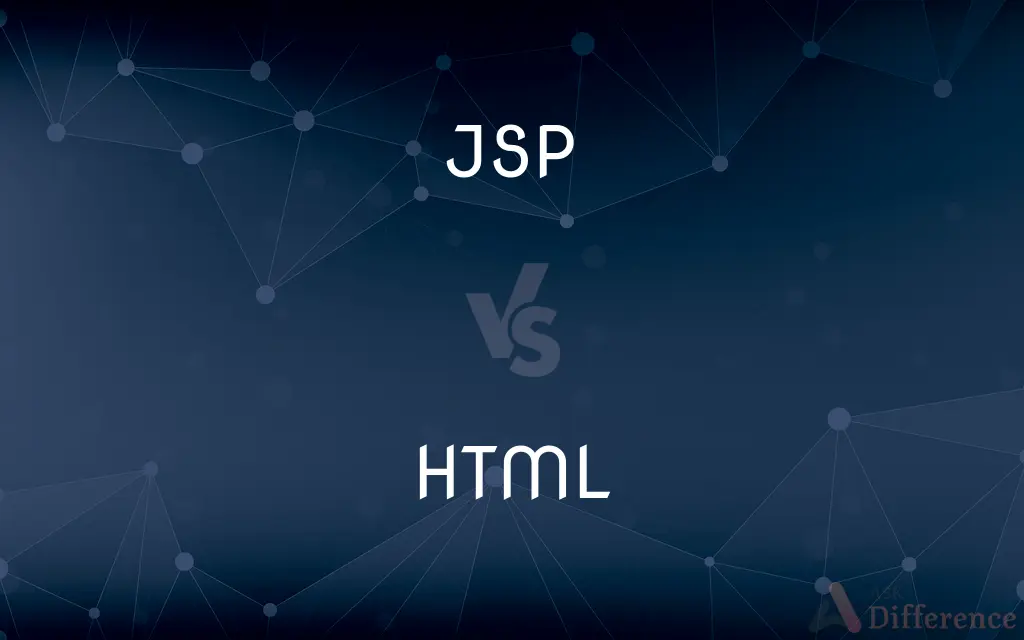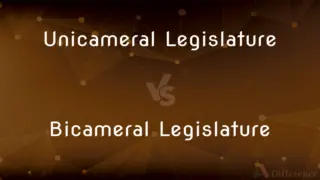JSP vs. HTML — What's the Difference?
By Tayyaba Rehman — Published on December 26, 2023
JSP is a Java technology for server-side web content generation, while HTML is a markup language for creating static web pages.

Difference Between JSP and HTML
Table of Contents
ADVERTISEMENT
Key Differences
JSP, or JavaServer Pages, is a server-side technology that allows developers to create dynamic web content using Java. HTML, or HyperText Markup Language, is the standard markup language used to design and structure content on web pages.
Both JSP and HTML are essential in web development, but they serve different purposes. While JSP deals with generating dynamic content based on user interaction or database content, HTML focuses on the static structure and presentation of a webpage.
A significant difference between JSP and HTML is where they execute. JSP runs on the server and generates HTML which is then sent to the client's browser. In contrast, HTML is rendered directly in the browser.
Another distinction lies in their functionalities. With JSP, developers can incorporate Java code directly into web pages, enabling more advanced functions and database interactions. HTML, however, is limited to presenting information and can't process logic or interact with databases on its own.
In essence, JSP can be seen as an extension that provides dynamic capabilities to the static nature of HTML, making the combination of JSP and HTML powerful for web development.
ADVERTISEMENT
Comparison Chart
Purpose
Generate dynamic web content
Design and structure static web content
Execution
Server-side
Client-side (in the browser)
Language Type
Server-side scripting
Markup language
Interactivity
Can interact with databases and other backend systems
Primarily static, needs JS for interactivity
Extensions
.jsp
.html or .htm
Compare with Definitions
JSP
Runs on the server to produce HTML.
Before the user sees the page, the JSP code is executed on the server.
HTML
Structures content on the web.
Every website uses HTML to structure its content.
JSP
Enables embedding Java in web pages.
The website pulls data using the JSP embedded Java code.
HTML
Static in nature.
HTML alone doesn't change based on user input.
JSP
Generates dynamic web pages.
JSP processes user input and displays personalized content.
HTML
A markup language for web pages.
HTML is fundamental for creating web page layouts.
JSP
Can integrate with databases.
With JSP, user profiles are fetched directly from the database.
HTML
Renders in the browser.
Browsers read the HTML to display the webpage correctly.
JSP
A server-side technology for web content.
Using JSP, we can create interactive web applications.
HTML
Uses tags to define elements.
The
tag in HTML defines a top-level heading.
HTML
A markup language used to structure text and multimedia documents and to set up hypertext links between documents, used extensively on the World Wide Web.
HTML
A set of tags and rules (conforming to SGML) for using them in developing hypertext documents
Common Curiosities
Is HTML a programming language?
No, HTML is a markup language used to structure content on web pages.
What's the primary purpose of HTML?
HTML (HyperText Markup Language) is used to design and structure static content on web pages.
Where is JSP code executed?
JSP code is executed on the server-side before sending the resulting content to the client.
Can HTML interact with databases?
On its own, HTML is static and doesn't interact with databases; this requires server-side technologies like JSP.
What is JSP?
JSP (JavaServer Pages) is a technology that enables the creation of dynamic web content using Java.
What kind of files does JSP produce?
JSP primarily produces HTML files which are rendered by the web browser.
Can JSP work without HTML?
While JSP generates dynamic content, it often outputs HTML for web browsers to render.
Can you use Java code directly in JSP?
Yes, JSP allows embedding of Java code directly into the web page for server-side processing.
Why would a developer choose JSP over other technologies?
Developers might choose JSP for its seamless integration with Java, making it suitable for Java-based web applications.
Can JSP and HTML be used together?
Yes, JSP often works in tandem with HTML, where JSP generates the dynamic parts of a web page, and HTML structures the content.
What's the standard file extension for HTML?
The standard file extensions for HTML are .html or .htm.
Is HTML dynamic?
By itself, HTML is static, but it can become dynamic when combined with JavaScript or server-side technologies like JSP.
What makes up the structure of an HTML document?
An HTML document is structured using tags, which define elements like headings, paragraphs, links, and lists.
Can you create a website using only HTML?
Yes, but it would be static. For dynamic features, one would integrate other technologies like JSP or JavaScript.
How does JSP differ from Servlets?
Both are Java technologies for server-side web development, but JSP is more webpage-centric while Servlets are Java-centric.
Share Your Discovery

Previous Comparison
DVI vs. VGA
Next Comparison
Unicameral Legislature vs. Bicameral LegislatureAuthor Spotlight
Written by
Tayyaba RehmanTayyaba Rehman is a distinguished writer, currently serving as a primary contributor to askdifference.com. As a researcher in semantics and etymology, Tayyaba's passion for the complexity of languages and their distinctions has found a perfect home on the platform. Tayyaba delves into the intricacies of language, distinguishing between commonly confused words and phrases, thereby providing clarity for readers worldwide.
















































